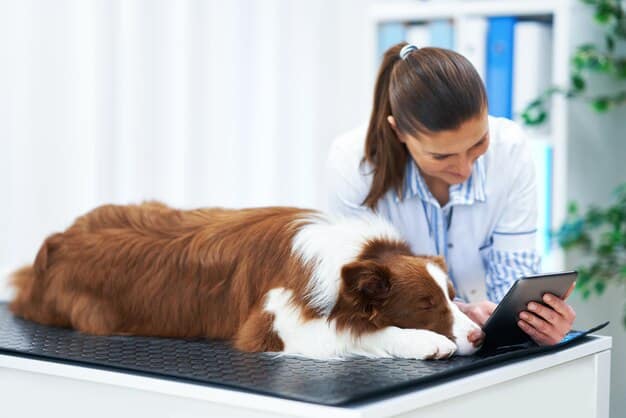New Research: Daily Exercise Extends Dog Lifespan & Improves Quality of Life

New research indicates that daily exercise significantly impacts a dog’s lifespan and overall quality of life, leading to improved cardiovascular health, mental well-being, and a stronger bond with their owners.
Discover how recent studies reveal the profound effects of daily exercise on your dog’s lifespan and well-being. Learn practical tips to ensure your furry friend enjoys a longer, healthier, and happier life through consistent physical activity. The key is understanding new research: the impact of daily exercise on your dog’s lifespan and quality of life.
The Science Behind Exercise and Longevity in Dogs
Recent studies have delved deep into the link between physical activity and the lifespan of dogs. These findings underscore the importance of exercise, not just for weight management, but for a range of physiological benefits that directly contribute to a longer and more fulfilling life for your canine companion.
Cardiovascular Health
One of the most significant advantages of regular exercise is its positive impact on cardiovascular health. Just like humans, dogs benefit from a stronger heart and improved circulation.
Bone and Joint Health
Exercise also plays a crucial role in maintaining healthy bones and joints. Regular physical activity helps to strengthen bones, reduce the risk of osteoporosis, and improve joint flexibility.
- Improved muscle strength supports joints, reducing strain and lowering the risk of injury.
- Weight-bearing exercises stimulate bone growth, increasing bone density and preventing age-related bone loss.
- Regular movement lubricates joints, reducing stiffness and discomfort.
- Consistent exercise can help manage symptoms of arthritis and other joint conditions.
In conclusion, understanding the science behind exercise and longevity in dogs reveals that regular physical activity is not just a luxury but a necessity for a long and healthy life.
Tailoring Exercise to Your Dog’s Breed and Age
Not all dogs are created equal, and their exercise needs vary significantly depending on their breed, age, and overall health. Understanding these differences is vital to creating a safe and effective exercise plan that maximizes the benefits without causing harm.

Breed-Specific Considerations
Different breeds have different energy levels and physical characteristics that influence their exercise requirements. For example, high-energy breeds like Border Collies and Huskies need significantly more exercise than lower-energy breeds like Bulldogs or Chihuahuas.
Adjusting for Age and Health Conditions
Age and health conditions also play a crucial role in determining the appropriate type and intensity of exercise. Puppies have different needs than adult dogs, and senior dogs may require modifications to their exercise routines due to age-related issues like arthritis.
- Puppies need moderate exercise to support bone and joint development, avoiding overexertion that can lead to injuries.
- Adult dogs benefit from a mix of cardio, strength training, and mental stimulation to stay fit and engaged.
- Senior dogs require gentle, low-impact exercises to maintain mobility and prevent stiffness.
- Dogs with health conditions like arthritis or hip dysplasia may need special exercises prescribed by a vet or canine physical therapist.
In short, tailoring the exercise plan to your dog’s specific needs is crucial for ensuring their well-being and maximizing the benefits of physical activity.
The Mental and Emotional Benefits of Daily Walks
The advantages of daily walks extend far beyond physical health; they also have profound effects on a dog’s mental and emotional well-being. These benefits are often overlooked but are just as important as the physical aspects of exercise.
Reducing Anxiety and Stress
Daily walks provide an outlet for pent-up energy and can significantly reduce anxiety and stress in dogs. Regular physical activity helps to release endorphins, which have mood-boosting effects.
Enhancing Socialization
Walking provides opportunities for dogs to socialize with other animals and people, which is essential for their emotional development.

- Exposure to new sights, sounds, and smells stimulates a dog’s senses and keeps their mind engaged.
- Positive interactions with other dogs and people can improve a dog’s confidence and reduce the risk of fear-based aggression.
- Consistent routines create a sense of security and predictability, which can be especially beneficial for anxious dogs.
- Exercise helps regulate sleep patterns, leading to better rest and improved overall mood.
In conclusion, the mental and emotional benefits of daily walks are undeniable, contributing to a happier, more balanced, and well-adjusted canine companion.
Creating a Safe and Effective Exercise Routine
Establishing a safe and effective exercise routine is paramount for ensuring your dog reaps the benefits of physical activity without risking injury or overexertion. This involves careful planning, monitoring, and adjustments based on your dog’s individual needs and abilities.
Start Slowly and Gradually Increase Intensity
Begin with short, low-intensity exercises and gradually increase the duration and intensity over time. This approach allows your dog’s body to adapt and reduces the risk of strain or injury.
Monitor for Signs of Overexertion
Pay close attention to your dog’s behavior during and after exercise. Signs of overexertion include excessive panting, limping, reluctance to continue, and exhaustion.
- Always provide fresh water and allow for frequent breaks during exercise sessions.
- Avoid exercising during the hottest parts of the day, especially in hot climates.
- Choose appropriate surfaces for exercise, avoiding rough or uneven terrain that can cause injuries.
- Consider using a harness instead of a collar to reduce pressure on your dog’s neck.
In essence, creating a safe and effective exercise routine requires attention to detail, careful monitoring, and a willingness to adapt the plan as needed to ensure your dog’s safety and well-being.
The Role of Diet and Nutrition in Supporting Exercise
While exercise is crucial for a dog’s health and longevity, it’s equally important to provide a balanced diet and proper nutrition to support their physical activity. Diet and exercise work synergistically to optimize a dog’s overall health and well-being.
Choosing High-Quality Dog Food
Opt for dog food that is formulated with high-quality ingredients and meets the nutritional needs of your dog’s age, breed, and activity level.
Timing Meals Around Exercise
Proper timing of meals around exercise sessions can also impact a dog’s performance and recovery. Avoid feeding your dog immediately before or after intense exercise to prevent digestive issues.
- Protein is essential for muscle repair and growth, so ensure your dog’s diet contains adequate amounts of high-quality protein sources.
- Carbohydrates provide energy for physical activity, but choose complex carbohydrates over simple sugars to support sustained energy levels.
- Fats are important for hormone production and overall health, but limit the amount of saturated fat in your dog’s diet.
- Supplements like glucosamine and chondroitin can support joint health, especially for dogs with arthritis or other joint conditions.
In conclusion, the role of diet and nutrition in supporting exercise cannot be overstated. A well-balanced diet provides the necessary fuel and nutrients to maximize the benefits of physical activity.
Tracking Progress and Making Adjustments
To maximize the long-term benefits of a daily exercise routine, it’s essential to track your dog’s progress and make adjustments as needed. Regular monitoring allows you to identify potential issues early on and fine-tune the exercise plan to meet your dog’s evolving needs.
Keep a Journal of Exercise Sessions
Maintain a record of your dog’s exercise sessions, including the type of activity, duration, intensity, and any observations about their behavior or physical condition. This information can be invaluable for identifying patterns and making informed decisions.
Consult with a Veterinarian
Regular check-ups with a veterinarian are crucial for monitoring your dog’s overall health and identifying any underlying issues that may impact their ability to exercise.
- Weigh your dog regularly to monitor their weight and adjust their diet and exercise plan as needed to maintain a healthy body condition.
- Measure your dog’s resting heart rate and respiration rate to establish a baseline and monitor for any changes that may indicate a health problem.
- Pay attention to your dog’s attitude and energy levels, and make adjustments to their exercise routine if they seem lethargic or disinterested.
- Consider using a fitness tracker designed for dogs to monitor their activity levels and sleep patterns.
In the final analysis, tracking progress and making adjustments is essential for ensuring your dog continues to thrive and enjoy the many benefits of daily exercise throughout their life.
| Key Point | Brief Description |
|---|---|
| ❤️ Cardiovascular Health | Improved heart function and circulation leads to increased longevity. |
| 💪 Bone & Joint Health | Strengthening bones/joints reduces injury risk and improves mobility. |
| 🧠 Mental Well-being | Reduces anxiety and promotes socialization for a happier dog. |
| 🐾 Tailored Exercise | Adjust exercise to breed, age, and health for safe benefits. |
Frequently Asked Questions
▼
Exercise needs vary by breed, age, and health. High-energy breeds need up to two hours daily, while smaller or senior dogs may need only 30 minutes. Monitor your dog’s energy and adjust as needed.
▼
Walking, running, playing fetch, and swimming are excellent choices. You can also engage in agility training, which exercises both body and mind. Consider your dog’s breed and physical capabilities when choosing.
▼
Begin slowly. A 15-20 minute walk can be great, extending it gradually. Watch for signs of fatigue. Engage gently and consistently, to build the dog’s stamina safely.
▼
Yes, especially without prep. Heatstroke, dehydration, injuries, and overexertion are vital concerns. Always provide water, exercise in moderate temps, and watch your dog’s behavior for potential overexertion.
▼
Include games, such as fetch or hide-and-seek. Vary routes to stimulate. Positive encouragement can motivate. Dog toys enhance all activities, making routines exciting.
Conclusion
Incorporating regular exercise into your dog’s daily life is a cornerstone of responsible pet ownership. By understanding the science behind exercise, tailoring activities to your dog’s specific needs, and monitoring their progress, you can significantly enhance their lifespan and quality of life, fostering a stronger bond and a happier, healthier companion.





